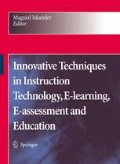Abstract
The aim of this paper is to present the development of remote learning laboratory for ultrasound medical diagnostics. We demonstrate the implementation of such laboratory using virtual instrument that is built by using standard PC, ultrasonic transducer with tissue like phantom, digitizer (Picoscope ADC 212/100, Picotech Ltd.), function generator (Hameg HM8131-2, Hameg Instruments GmbH) and popular software package LabView (National Instruments Inc.). By controlling the virtual instrument it is possible to excite and receive ultrasound waves in pulse echo mode then process the received echographic signal and get the characteristics of tissue like phantom. The tissue like phantom is characterized with thickness and density also with the speed of waves propagation and attenuation coefficient. The students are motivated by the assignment of the clear task - to identify the material from which the phantom is made. The implemented virtual instrument is based on NI Remote panel technology. This technology allows to access the virtual instrument remotely using internet browse. The lab preparation materials: goal, theory, quizzes are available from e-learning platform Moodle. We expect the students will improve their knowledge of ultrasound tissue characterization using our remote hands-on labwork.
Access this chapter
Tax calculation will be finalised at checkout
Purchases are for personal use only
Preview
Unable to display preview. Download preview PDF.
References
“John Dewey”, Wikipedia http://en.wikipedia.org/wiki/John Dewey
S. Grober, M. Vetter, B. Eckert and H.-J. Jodl, “Experimenting from a distance—remotely controlled laboratory (RCL)”, Eur. J. Phys., vol. 28, pp. S127-S141, 2007.
Bertrand, Y.; Flottes, M.-L.; Azais, F.; Bernard, S.; Latorre, L.; Lorival, R., “A remote access to engineering test facilities for the distant education of European microelectronics students,” Frontiers in Education, vol. 1, 6-9 Nov. 2002 p. T2E-24 - T2E-29
Sanchez, J.; Dormido, S.; Pastor, R.; Morilla, F; “A Java/Matlab-based environment for remote control system laboratories: illustrated with an inverted pendulum” Education, IEEE Transactions on, vol. 47, Issue 3, Aug. 2004, p 321 – 329
Gao-Wei Chang; Zong-Mu Yeh; Hsiu-Ming Chang; Shih-Yao Pan “Teaching photonics laboratory using remote-control web technologies”; Education, IEEE Transactions on Volume 48, Issue 4, Nov. 2005 Page(s):642 – 651
R. C. Almgren, J. A. Cahow, “Evolving Technologies and Trends for Innovative Online Delivery of Engineering Curriculum”, Intern. J. Online Eng., vol. 1, no. 1, 2005. http://www.i-joe.org/ojs/include/getdoc.php?id=39&article=5&mode=pdf
J. Bourne, D. Harris, F. Mayadas, “Online Engineering Education: Learning Anywhere, Anytime”, J. of Eng. Edu., vol. 94, no. 1, pp. 131–146, January 2005.
J. Garcia-Zubia, D. Lopez-de-Ipina, U. Hernandez, P. Orduna, I, Trueba, “An Approach for WebLabs Analysis”, Intern. J. Online Eng., vol. 3, no. 2, 2007. http://www.i-joe.org/ojs/include/getdoc.php?id=374&article=119&mode=pdf
H. Ewald, G.S. Page, “Performing Experiments by Remote Control Using the Internet”, Global J. of Engng. Educ., vol. 4, no. 3, pp. 287-292, 2000.
Statistics data from Kaunas University of Medicine Hospital, 2003, Kaunas, Lithuania [unpublished].
G. Schmitz, H. Ermert, and T. Senge, “Tissue-Characterization of the Prostate using Radio Frequency Ultrasonic Signals”, IEEE Trans. on Ultrason, Ferroel, and Freq. Control, vol. 46, no.1, January 1999. p. 126– 138.
Pai-Chi Li and Sheng-Wen Huang, “Ultrasound Tomography of the Breast Using Linear Array”, IEEE ICASSP 2005, pp.989-992.
J. E. Hancock, J. C. Cooke, D. T. Chin and M. J. Monaghan, “Determination of Successful Reperfusion After Thrombolysis for Acute Myocardial Infarction: A Noninvasive Method Using Ultrasonic Tissue Characterization That Can Be Applied Clinically”, Circulation, 2002; 105; p.157-161.
Yan Shi, R. S. Witte, and M. O’Donnell, “Identification of Vulnerable Atherosclerotic Plaque Using IVUS-Based Thermal Strain Imaging”, IEEE Trans. on Ultrason, Ferroel, and Freq. Control, vol. 52, no.5, May 2005. p. 844— 850.
L.A. Negron, F. Viola, E.P. Black, C.A. Toth, W.F. Walker, “Development and Characterization of a Vitreous Mimicking Material for Radiation Force Imaging” IEEE Trans. on Ultrason, Ferroel, and Freq. Control, vol. 49, Issue 11, November 2002 p. 1543 – 1551.
Vlad, R.M.; Czarnota, G.J.; Giles, A.; Sherar, M.D.; Hunt, J.W.; Kolios, M.C.; “High frequency ultrasound in monitoring liver suitability for transplantation” Ultrasonics Symposium, 2004 IEEE, vol. 2, 23-27 Aug. 2004, p. 830 – 833, vol.2
C. F. Njeh, T. Fuerst, E. Diessel and H. K. Genant, “Review Article: Is Quantitative Ultrasound Dependent on Bone Structure?” Osteoporos Int. (2001) 12:1–15
Pellaumail, B.; Dewailly, V.; Watrin, A.; Loeuille, D.; Netter, P.; Berger, G.; Saied, A.; “Attenuation coefficient and speed of sound in immature and mature rat cartilage: a study in the 30-70 MHz frequency range,” Ultrasonics Symposium, 1999. Proceedings. 1999 IEEE, vol. 2, 17-20 Oct. 1999 p. 1361 - 1364
Jirik R., Taxt T. and Jan J., “Ultrasound Attenuation Imaging” J. Elec.Eng., vol.55, no.7-8, p. 180-187. 2004.
J. A. Zagzebski, A. Gerig, Q. Chen, H. Tu, Wu Liu, T. Varghese, and T. Hall, “Parametric Imaging Using A Clinical Scanner”, 2004 IEEE International Ultrasonics, Ferroelectrics, and Frequency Control Joint 50th Anniversary Conference, pp. 2165-2168.
National instruments Inc. LabView website, http://www.ni.com/labview/
R. Jurkonis, V. Marozas, A. Lukoševičius, Ultrasound Medical Diagnostics: Practical lab works with virtual instruments (in Lithuanian). Kaunas: Technologija, 2007. ISBN : 978-9955-25-337-2.
Ch. Graciet, B. Hosten, “Simultaneous measurement of speed, attenuation, thickness and density with reflected ultrasonic waves in plates,” Ultrasonics Symposium, pp. 1219-1222, 1994.
J. M. Ferreira, A. M. Cardoso, “A Moodle extension to book online labs”, Intern. J. Online Eng., vol. 1, no. 2, 2005. http://www.i-joe.org/ojs/include/getdoc.php?id=118&article=21&mode=pdf
R. Jurkonis, V.Marozas, and S.Kurapkienė, “Development and evaluation of virtual instrument to supplement ultrasonic echoscope system for ophthalmology,” Ultrasound, [Ultragarsas (in Lithuanian), ISSN 1392-2114,] vol. 1(62), pp. 12-17, 2007.
Author information
Authors and Affiliations
Editor information
Editors and Affiliations
Rights and permissions
Copyright information
© 2008 Springer Science+Business Media B.V.
About this paper
Cite this paper
Jurkonis, R., Marozas, V., Lukoševičius, A. (2008). Ultrasound Medical Diagnostics Laboratory for Remote Learning in EVICAB*Campus. In: Iskander, M. (eds) Innovative Techniques in Instruction Technology, E-learning, E-assessment, and Education. Springer, Dordrecht. https://doi.org/10.1007/978-1-4020-8739-4_80
Download citation
DOI: https://doi.org/10.1007/978-1-4020-8739-4_80
Publisher Name: Springer, Dordrecht
Print ISBN: 978-1-4020-8738-7
Online ISBN: 978-1-4020-8739-4
eBook Packages: Computer ScienceComputer Science (R0)

